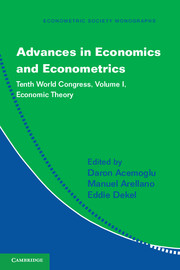Book contents
- Frontmatter
- Contents
- Contributors
- Preface
- I NONSTANDARD MARKETS
- II CONTRACTS
- III DECISION THEORY
- IV COMMUNICATION/ORGANIZATIONS
- 10 Giving and Receiving Advice
- 11 Organizational Economics with Cognitive Costs
- V FOUNDATIONS: EPISTEMICS AND CALIBRATION
- VI PATENTS: PROS AND CONS FOR INNOVATION AND EFFICIENCY
- Name Index
- Miscellaneous Endmatter
10 - Giving and Receiving Advice
Published online by Cambridge University Press: 05 May 2013
- Frontmatter
- Contents
- Contributors
- Preface
- I NONSTANDARD MARKETS
- II CONTRACTS
- III DECISION THEORY
- IV COMMUNICATION/ORGANIZATIONS
- 10 Giving and Receiving Advice
- 11 Organizational Economics with Cognitive Costs
- V FOUNDATIONS: EPISTEMICS AND CALIBRATION
- VI PATENTS: PROS AND CONS FOR INNOVATION AND EFFICIENCY
- Name Index
- Miscellaneous Endmatter
Summary
Introduction
Models of signaling, adverse selection, and moral hazard make it clear that differences in information can lead to inefficiency. Workers may invest in nonproductive education to convince an employer they have skills. Markets may fail when sellers know more about the quality of their item than buyers. Risk-neutral principals may fail to offer perfect insurance to risk-averse workers when they cannot directly observe the workers' choice of effort.
If asymmetric information leads to inefficiency, can agents improve outcomes by direct, costless communication? This question motivates the study of “cheap-talk” models. It has a straightforward answer. In simple economic environments, it is not in the interest of one agent to reveal private information to another. Naive and honest sellers who accurately reveal the quality of their item may lose all bargaining power. Credulous employers who believe a worker's claims about productivity encourage workers to make exaggerated claims about their quality. Adding realistic complications to these situations create situations in which this kind of cheap talk can be beneficial.
In this chapter, I discuss some concepts central to the study of communication. I illustrate most of the ideas using a model in which there is an informed agent who has the ability to communicate with an uninformed decision maker. The informed Sender gives advice; the uninformed Receiver decides how to use it. The fundamental questions in this environment are: How credible can communication be?
- Type
- Chapter
- Information
- Advances in Economics and EconometricsTenth World Congress, pp. 305 - 341Publisher: Cambridge University PressPrint publication year: 2013
- 58
- Cited by

